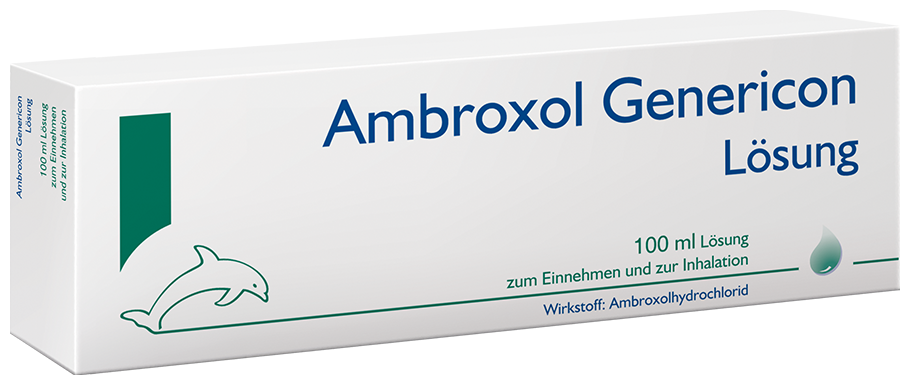Genericon
Genericon Ambroxol solution 100 ml
Genericon Ambroxol solution 100 ml
5.0 / 5.0
(1) 1 total reviews
Couldn't load pickup availability
Ambroxol hydrochloride, the active ingredient in Ambroxol Genericon, loosens congested and viscous secretion from the bronchial wall, making it easier to cough up.
Ambroxol Genericon is used together with plenty of liquid for expectorant treatment in acute and chronic diseases of the respiratory tract (bronchi and lungs) with viscous mucus.
If you do not feel better or if you feel worse after 5 days, contact your doctor.
Contraindications
Ambroxol Genericon must not be used
- if you are allergic to ambroxol hydrochloride, sodium metabisulfite, sodium methyl parahydroxybenzoate, sodium propyl parahydroxybenzoate or any of the other ingredients of this medicine (listed in section 6).
- by people, especially asthmatics, suffering from sulfite intolerance.
interactions
Other medicines and Ambroxol Genericon Tell
your doctor or pharmacist if you are taking/using, have recently taken/used or might take/use any other medicines.
No significant interactions are known.
In laboratory tests, the concomitant administration of ambroxol hydrochloride, the active substance in Ambroxol Genericon, and certain anti-infective medicines (the antibiotics amoxicillin, cefuroxime, doxycycline and erythromycin) leads to higher antibiotic concentrations in the bronchial mucus and sputum.
The ingredient sulfite is a reactive compound. Mixtures with other medicinal products should therefore be avoided.
Pregnancy and breast-feeding
If you are pregnant or breast-feeding, think you may be pregnant or are planning to have a baby, ask your doctor or pharmacist for advice before using this medicine.
The use of Ambroxol Genericon is not recommended during pregnancy, especially during the first 3 months.
Ambroxol hydrochloride passes into breast milk. The use of Ambroxol Genericon is therefore not recommended during breast-feeding.
application
Always use this medicine exactly as described in this leaflet or as your doctor or pharmacist has told you. Check with your doctor or pharmacist if you are not sure.
The recommended dosage is:
For inhalation
Children:
0 - 6 years: 1 - 2 inhalations daily with 2 ml solution each.
Adults, adolescents and children over 6 years:
1 - 2 inhalations daily with 2 - 3 ml of solution.
If only one inhalation per day is possible, Ambroxol should also be taken as a solution or in the form of tablets or juice.
Oral use
Children:
0-2 years: 1 ml
2 times a day 2-6 years: 1 ml 3 times a day
6-12 years: 2 ml 2-3 times a day
Ambroxol Genericon may only be given to children under 2 years of age on medical advice.
Adults and adolescents over 12 years:
4 ml 3 times a day for the first 2-3 days of treatment, then 2 ml 3 times a day.
In severe cases, the treatment regimen is maintained at 4 ml 3 times a day.
Use in patients with impaired kidney and/or liver function
If you have severe kidney or liver function impairment, you must consult your doctor before use, as your doctor may reduce the dose accordingly or increase the interval between applications.
Method of
administration Ambroxol Genericon is suitable for inhalation and oral use.
A measuring cup with graduations from 1 to 10 ml is included with the preparation.
For reasons of hygiene, the measuring cup must be rinsed out and dried after each use.
If Ambroxol Genericon is taken, it should be taken after meals with sufficient liquid.
If Ambroxol Genericon is inhaled, a suitable inhalation device must be used (observe the instructions for use). When used in a respirator, distilled water can be added to the solution in a ratio of 1:1. Since inhaling too deeply can cause coughing, you should inhale and exhale normally when inhaling. Patients with bronchial asthma (chronic inflammatory disease of the airways) should use a bronchospasmolytic (drug to widen the bronchi) before inhalation to open the airways and avoid unspecific inhalation stimuli.
Note: The expectorant effect of Ambroxol Genericon is enhanced by fluid intake (juice, tea, water).
Duration of application
The duration of application must be decided individually depending on the area of application and the course of the disease.
If you do not feel better or even worse after 5 days, contact your doctor.
side effects
Like all medicines, this medicine can cause side effects, although not everybody gets them.
Common side effects (may affect up to 1 in 10 people)
- changes in taste sensation
- numbness in the throat
- Nausea, numbness in the mouth and throat
Uncommon side effects (may affect up to 1 in 100 people)
- Vomiting, diarrhoea, indigestion (dyspepsia), abdominal pain, dry mouth
Rare side effects (may affect up to 1 in 1,000 people)
- hypersensitivity reactions
- Rash, hives
Side effects with frequency not known (cannot be estimated from the available data)
- allergic reactions up to anaphylactic shock, angioedema (rapidly developing swelling of the skin, subcutaneous tissue, mucous membrane or tissue under the mucous membrane) and itching
- severe skin reactions (including erythema multiforme, Stevens-Johnson syndrome/toxic epidermal necrolysis and acute generalized exanthematous pustulosis).
- dryness of the throat
Sodium metabisulfite can rarely cause hypersensitivity reactions and bronchial spasms (bronchospasm), especially in asthmatics.
Sodium methyl-4-hydroxybenzoate and sodium propyl-4-hydroxybenzoate can cause hypersensitivity reactions, also delayed reactions and rarely a spasm of the airways (bronchospasm).
composition
The active substance is ambroxol hydrochloride.
1 ml solution contains 7.5 mg ambroxol hydrochloride.
The other ingredients are: citric acid monohydrate, sodium methyl parahydroxybenzoate (E219), sodium propyl parahydroxybenzoate (E217), sodium metabisulphite (E223, equivalent to 0.135 mg SO2), sodium hydroxide, purified water.
Share


